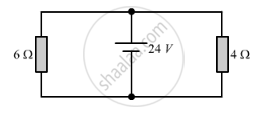Advertisements
Advertisements
प्रश्न
Two resistors having resistance 8 Ω and 12 Ω are connected in parallel. Find their equivalent resistance.
उत्तर
Let R be the equivalent resistance
∴ `1/"R" = 1/"R"_1 + 1/"R"_2`
`1/"R" = 1/8 + 1/12`
= `(3 +2)/24`
`1/"R" = 5/24`
R = `24/5`
= 4.8 Ω
or R = `("R"_1"R"_2)/("R"_1 + "R"_2)`
= `(8 xx 12)/((8 + 12))`
= 4.8 Ω

संबंधित प्रश्न
Complete the following :-
(b)

Find the current in each resistor in the circuit shown below:

Two resistors, with resistance 5 Ω and 10 Ω respectively are to be connected to a battery of emf 6 V so as to obtain:
(i) minimum current flowing
(ii) maximum current flowing
(a) How will you connect the resistances in each case?
(b) Calculate the strength of the total current in the circuit in the two cases.
Four resistors each of resistance 2Ω are connected in parallel. What is the effective resistance?
A battery of e.m.f. 15 V and internal resistance 2 `Omega` is connected to tvvo resistors of 4 ohm and 6 ohm joined.
(i) In series,
(ii) In para 1 lel. Find in each case the electrica I energy spent per minute in 6 ohm resistor.
A particular resistance wire has a resistance of 3 ohm per meter. Find the potential difference of the battery which gives a current of 2 A in each of the 1.5 m length when connected in the parallel to the battery (assume that resistance of the battery is negligible).
How does the resistance of a metallic wire depend on the length of wire?
A given wire is stretched to double its length. How will its resistance change?
Two resistors when connected in parallel give the resultant resistance of 2 ohms, but when connected in series the effective resistance becomes 9 ohms. Calculate the value of each resistance.
You are given four ammeters A, B, C and D having the least counts mentioned below:
(I) Ammeter A with least count 0.25 A
(II) Ammeter B with least count 0.5 A
(III) Ammeter C with least count 0.05 A
(IV) Ammeter D with least count 0.1 A
Which of the ammeters would you prefer for doing an experiment to determine the equivalent resistance of two resistances most accurately, when connected in parallel?
